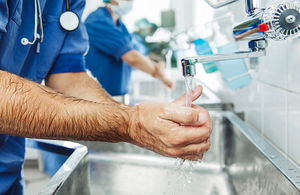Reducing infections in the NHS
Plans to prevent hospital infections include more money for hospitals who reduce infection rates and publishing E. coli rates by local area.

Surgeons washing their hands
Health Secretary Jeremy Hunt has launched new plans to reduce infections in the NHS. He announced government plans to halve the number of gram-negative bloodstream infections by 2020 at an infection control summit.
E. coli infections – which represent 65% of what are called gram-negative infections – killed more than 5,500 NHS patients last year and are set to cost the NHS £2.3 billion by 2018. There is also large variation in hospital infection rates, with the worst performers having more than 5 times the number of cases than the best performing hospitals.
Infection rates can be cut with better hygiene and improved patient care in hospitals, surgeries and care homes, such as ensuring staff, patients and visitors regularly wash their hands. People using insertion devices such as catheters, which are often used following surgery, can develop infections like E. coli if they are not inserted properly, left in too long or if patients are not properly hydrated and going to the toilet regularly.
These new plans build on the progress made in infection control since 2010 – the number of MRSA cases has been reduced by 57% and C. difficile by 45%.
Health Secretary Jeremy Hunt said,
The NHS can rightly be proud that in the last 6 years we’ve reduced the number of MRSA cases by 57% and C. difficile by 45%. These aren’t abstract numbers – they show that we have prevented the needless suffering – sometimes fatal suffering – of over 60,000 people in that period. Because every avoidable infection also has a financial cost, we know that progress has also saved the NHS over half a billion pounds.
The government’s plans to prevent NHS infections include:
- more money for hospitals making the most progress in reducing infection rates with a new £45 million quality premium
- independent Care Quality Commission (CQC) inspections focusing on infection prevention based on E. coli rates in hospitals and in the community, and taking action against poor performers
- the NHS publishing staff hand hygiene indicators for the first time
- displaying E. coli rates on wards, making them visible to patients and visitors in the same way that MRSA and C. difficule are currently
- improving training and information sharing so NHS staff can learn from the best in cutting infection rates
- appointing a new national infection lead, Dr Ruth May
Dr Ruth May, new national infection and prevention lead, said:
This is a clear plan to achieve real change across the NHS focusing on a combination of strict oversight from the CQC and the collection, publication and intelligent use of data which will ensure organisations improve infection control and help us to make sure poor performers get the support they need to improve quickly.
Alongside the plan to reduce E. coli rates, an additional £60 million will be allocated to the ‘Getting It Right First Time’ programme. First pioneered by Professor Tim Briggs in orthopaedics, the programme will now be expanded to another 18 surgical specialties, building on the initial investment of £2.5 million.
The Getting It Right First Time programme seeks to improve patient experience by replicating the work of the best clinicians across the health service, including cutting infection rates resulting from surgery. The expansion of the programme will focus on infection control and aims to save the NHS £1.5 billion each year.
Health Secretary Jeremy Hunt said:
Taken together, these measures are intended to achieve a dramatic reduction in hospital infections, reducing enormous human pain and suffering in the process. They will make us better at knowing when to use antibiotics and better at knowing when not to use them. They will save doctors and nurses time, and save the NHS money. But most of all they will be another vital step in making NHS care something we can all be proud of as the safest and highest quality anywhere on the planet.
These new plans are also part of the government’s commitment to tackle antimicrobial resistance, which includes resistance to antibiotics.
E. coli infections have increased by a fifth in the last 5 years. Targeting preventable infections like E. coli helps to make surgeries and care homes safer for patients and reduce the need for antibiotics, therefore reducing the opportunity for infections to develop a resistance to them.
Updates to this page
-
Removed figures regarding e-coli infection rates. The data, based on a study’s findings, had been oversimplified.
-
First published.